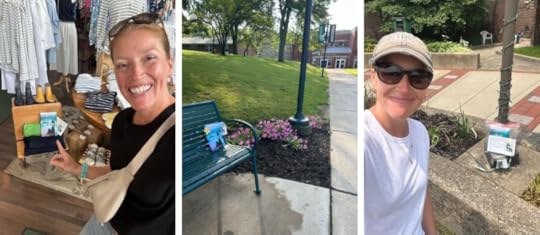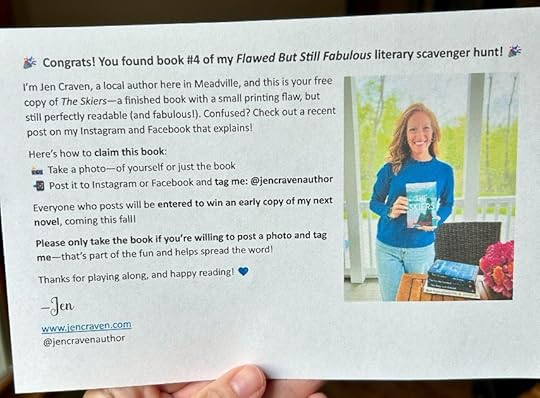How a Box of Misprinted Books Became My Most Creative Marketing Tool Yet

Today’s post is by author Jen Craven.
When I opened the shipment of newly printed copies of my novel The Skiers, I was riding the high of release season. But that excitement quickly dipped when I realized a handful of books had slight printing flaws—wonky text on the chapter titles and headings.
Readable? Totally. Sellable? Meh … not really.
At first, I was disappointed (read: seriously annoyed). I didn’t want to throw them out (as an author, the idea of books in the trash is practically sacrilegious), and I didn’t love the idea of mailing them to readers as official review or giveaway copies. But I kept circling back to a simple truth: these books still worked. They still had value.
That’s when the idea hit me—if these books weren’t perfect, maybe they could still be fabulous in a different way.
The “Flawed But Fabulous” Scavenger HuntInstead of discarding the misprinted copies, I decided to turn them into a literary experience. Over the course of a month, I launched a local book scavenger hunt in my hometown of Meadville, Pennsylvania, hiding fifteen flawed-but-readable copies of The Skiers in public places and small businesses.
 Some of my clue locations included, from left to right, a local boutique, park bench on Allegheny College campus, and outside our ice rink.
Some of my clue locations included, from left to right, a local boutique, park bench on Allegheny College campus, and outside our ice rink.Each book included a note explaining the contest and inviting the finder to post a photo and tag me on social media. Anyone who participated was entered to win an advanced copy of my upcoming release this fall. Every location featured a clever rhyming clue (think: “Where custard swirls and cones delight, a story waits just out of sight”) posted to my social accounts to generate buzz.
The result? Far more than I expected.
 The best book promo I never planned
The best book promo I never plannedWhat began as a creative workaround to a printing problem turned into one of the most meaningful—and effective—marketing efforts I’ve done in years. Within days of launching the hunt, something magical happened. People started talking. Posting. Sharing. Even those who didn’t find a copy were engaged, following the clues like they were part of a community game. Plot twist: The flaws ended up being the feature.
Here’s what I gained from the experience:
 Media attention: The local newspaper picked up the story and featured it on the front page, turning a grassroots effort into a community-wide event. That publicity led to increased social engagement and new followers (Readers would DM me things like: “Ah! I think I know where this one is. I can’t get there today, but will you let me know if I’m right!?”)Local partnerships: I collaborated with bookstores, cafés, parks, and even wineries, building relationships that could benefit future events or book launches. Many were excited and thankful I chose them as one of my hiding spots.Increased visibility: With every tagged post, my book—and my brand—reached new readers, especially local followers who may not have discovered me online otherwise.Sales bump: While the goal wasn’t direct sales, I saw a modest but noticeable uptick in local purchases, and inquiries about signed copies. Of course, I always directed them to my favorite indie bookstore to encourage #shopsmall!Community engagement: Most importantly, it promoted literacy and accessibility. People who may not regularly visit bookstores were thrilled to find a free novel in the wild—no strings, no cost, just the love of reading. It brought books to readers in a fresh, unexpected way—something that’s often hard to do in an industry saturated with noise.
Media attention: The local newspaper picked up the story and featured it on the front page, turning a grassroots effort into a community-wide event. That publicity led to increased social engagement and new followers (Readers would DM me things like: “Ah! I think I know where this one is. I can’t get there today, but will you let me know if I’m right!?”)Local partnerships: I collaborated with bookstores, cafés, parks, and even wineries, building relationships that could benefit future events or book launches. Many were excited and thankful I chose them as one of my hiding spots.Increased visibility: With every tagged post, my book—and my brand—reached new readers, especially local followers who may not have discovered me online otherwise.Sales bump: While the goal wasn’t direct sales, I saw a modest but noticeable uptick in local purchases, and inquiries about signed copies. Of course, I always directed them to my favorite indie bookstore to encourage #shopsmall!Community engagement: Most importantly, it promoted literacy and accessibility. People who may not regularly visit bookstores were thrilled to find a free novel in the wild—no strings, no cost, just the love of reading. It brought books to readers in a fresh, unexpected way—something that’s often hard to do in an industry saturated with noise.One of the most rewarding outcomes? My friend and fellow author Sharon M. Peterson saw what I was doing and decided to replicate it in her small Washington town. She, too, hid books and saw the same ripple effects—heightened engagement, new readers, and a whole lot of local joy. So fun! It was proof that this kind of grassroots, author-driven campaign could work beyond just one zip code.
Creative ways to use flawed or extra booksWhether you’ve got misprints, advance review copies, or simply surplus stock, there are countless ways to turn those “extra” copies into marketing gold. Here are some inventive, outside-the-box strategies to consider:
Host a town-wide scavenger hunt: Like I did! It’s fun, interactive, and builds genuine community buzz. Add riddles, photo challenges, or team play for more depth.Create a “Blind Date with a Flawed Book” display: Wrap misprinted books in brown paper and leave them in Little Free Libraries or partner businesses. Add a teaser: “Flawed on the outside. Fabulous on the inside.”Tuck them into Airbnb guest rooms: Reach out to local Airbnb hosts and offer a copy for their welcome basket. It’s unexpected, memorable, and might turn a guest into a new fan.Collaborate with a local artist: Let a local artist turn the flawed cover into a painted bookplate or altered art piece—then give it away as a one-of-a-kind collector’s edition.Donate to prison libraries or youth centers: These under-resourced communities often lack access to recreational reading materials. Imperfections are more than acceptable—and the gesture is deeply appreciated.Host a “read & release” pop-up: Invite people to take a book, read it, and leave it somewhere new for someone else. Add a sticker tracking its journey (à la BookCrossing).Use for guerrilla marketing in unexpected places: Leave a book on a train, at a laundromat, or tucked inside a shopping cart with a note: “Free book! Take me home!” Bonus if your contact info is inside. (I often do this at airports when I travel, and it’s fun knowing your book will be with a reader in a city/state it might not otherwise have reached).Run a “Find the Flaw” contest: Invite readers to identify the printing error for a chance to win a flawless copy or other prize. It’s engaging and light-hearted.Craft a book-themed photo booth at events: Use flawed books to create a stunning visual backdrop or display at signings or festivals. Readers can snap pics and tag you.Use as giveaway bonuses: Offer “flawed but fabulous” copies as a bonus to readers who preorder, review, or join your mailing list.My books are both traditional and self-published. Because The Skiers is a self-published novel, I had full control over how to distribute the misprinted copies. Traditionally published authors may need to obtain permission from their publisher or return defective inventory, so be sure to check your contract or publisher guidelines before launching a similar campaign.
Lessons from a misprintAuthors are often told to think like marketers. But we don’t always hear that marketers should also think like creatives. This experience reminded me that not everything in publishing—or marketing—has to be polished to perfection. Sometimes, the best ideas are born out of imperfection.
If I’d tossed those flawed copies, I would’ve missed out on a powerful opportunity—not just for exposure, but for connection. I met new readers, collaborated with local businesses, and celebrated the simple joy of storytelling.
As authors, we often talk about how to get our books into readers’ hands. But sometimes, it’s about getting creative with how they find them. After all, isn’t that the heart of storytelling? Unexpected discoveries. A little mystery.
So next time you find yourself with a stack of not-quite-right books, don’t reach for the recycling bin. Instead, ask: What story can I still tell with these?
You might be surprised by how many people want to read it.
Jane Friedman
- Jane Friedman's profile
- 1885 followers



